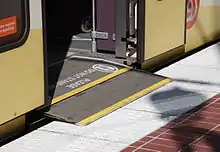Bridge plate (mechanism)
A bridge plate, or bridgeplate, is a mechanical, movable form of wheelchair ramp that is used on some low-floor light rail vehicles (LRVs) to provide for wheelchair access. The bridge plate extends from the vehicle to the platform, which must be raised to close to the level of the floor of the vehicle so that the wheelchair need not travel over an excessively steep ramp (in the United States, the Americans with Disabilities Act specifies that the slope must be no more than 1 inch of rise for every 12 inches of length). Some low-floor buses also use bridge plates (in this case, extending to the curb) to provide for wheelchair access, but many low-floor buses instead use a ramp that normally serves as part of the floor but can be flipped out through the door (using a hinge at the door) onto the curb or street; in this case the ramp is long enough that it can serve as a true wheelchair ramp rather than a bridge without being excessively steep.

Bridge plates can be manually deployed (by the vehicle operator or other crew person) or powered, rectractable ramps.[1] The first passenger rail cars in North America to be equipped with retractable bridge plates were TriMet's (Portland, Oregon) Siemens SD660 LRVs,[2] the first of which were completed in 1996.[3] Earlier, in 1987, the newly opened Sacramento RT Light Rail system used non-powered, station-platform-mounted bridge plates to bridge the gap between a high-platform section at each station and the floor of an LRV.[4]
Manually operated bridge plates
On some railway stations in France and the United Kingdom, it may not be possible provide permanent level access from the platform to the train if different types of trains pass through or serve the station. To overcome this issue, a station may have one or more staff-operated boarding ramp on the platforms, to be deployed when a wheelchair user boards the train.[5]
See also
References
- "Modern Streetcar Vehicle Guideline" (PDF). American Public Transportation Association. March 2013. p. 37 [p. 40 of PDF]. Archived from the original (PDF) on 2018-04-23. Retrieved 2018-07-10.
- Vantuono, William C. (February 12, 2016). "Retractable bridge plates a first for Brightline". Railway Age. Archived from the original on July 10, 2018. Retrieved July 9, 2018.
- Oliver, Gordon (August 1, 1996). "MAX takes keys to cool new model". The Oregonian. p. D1.
- "Special Report 221: Light Rail Transit – New System Successes at Affordable Prices" (PDF). Transportation Research Board. May 1988. Section "Sacramento", pp. 157–161. Retrieved 2018-07-09.
- "Step-free access arrives at four eastern TfL Rail stations". Transport for London. 5 March 2019. Archived from the original on 8 March 2019. Retrieved 8 March 2019.